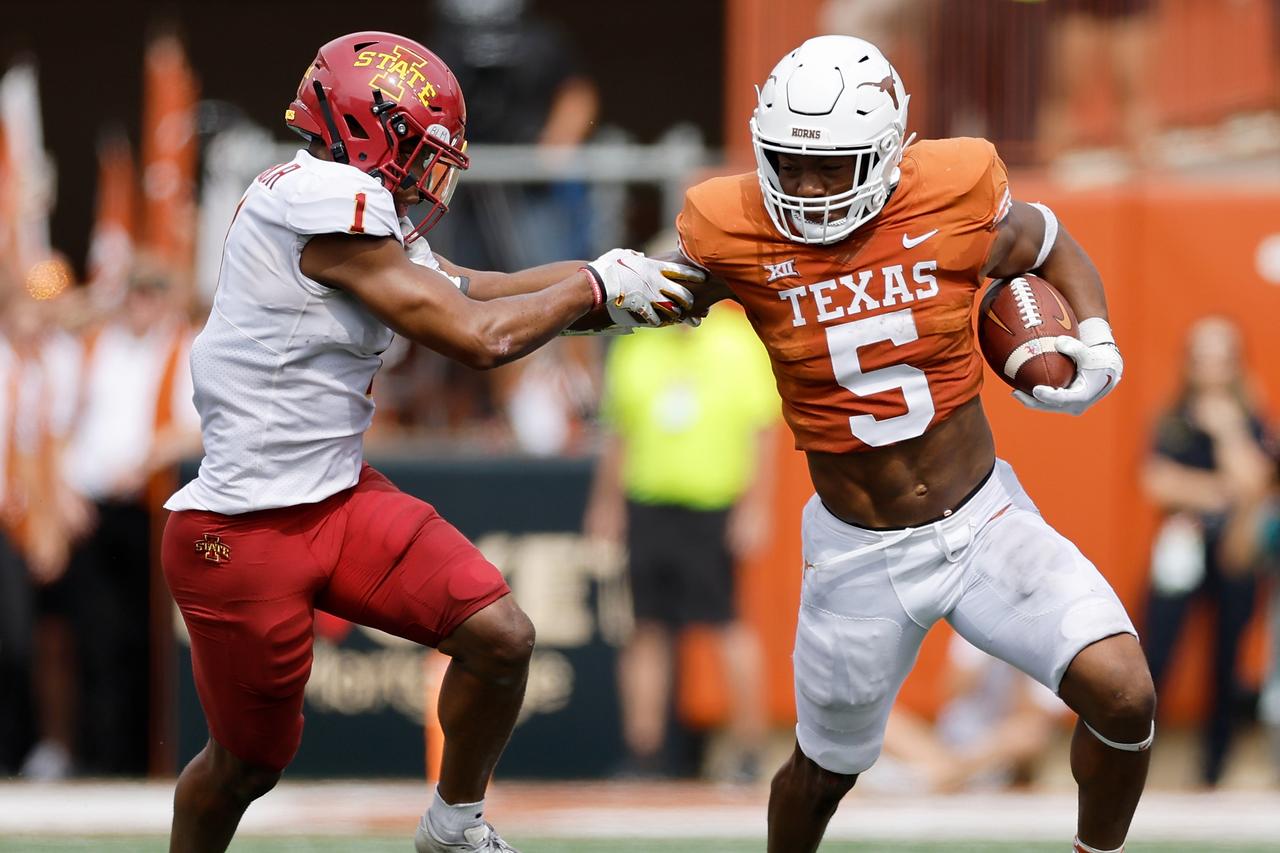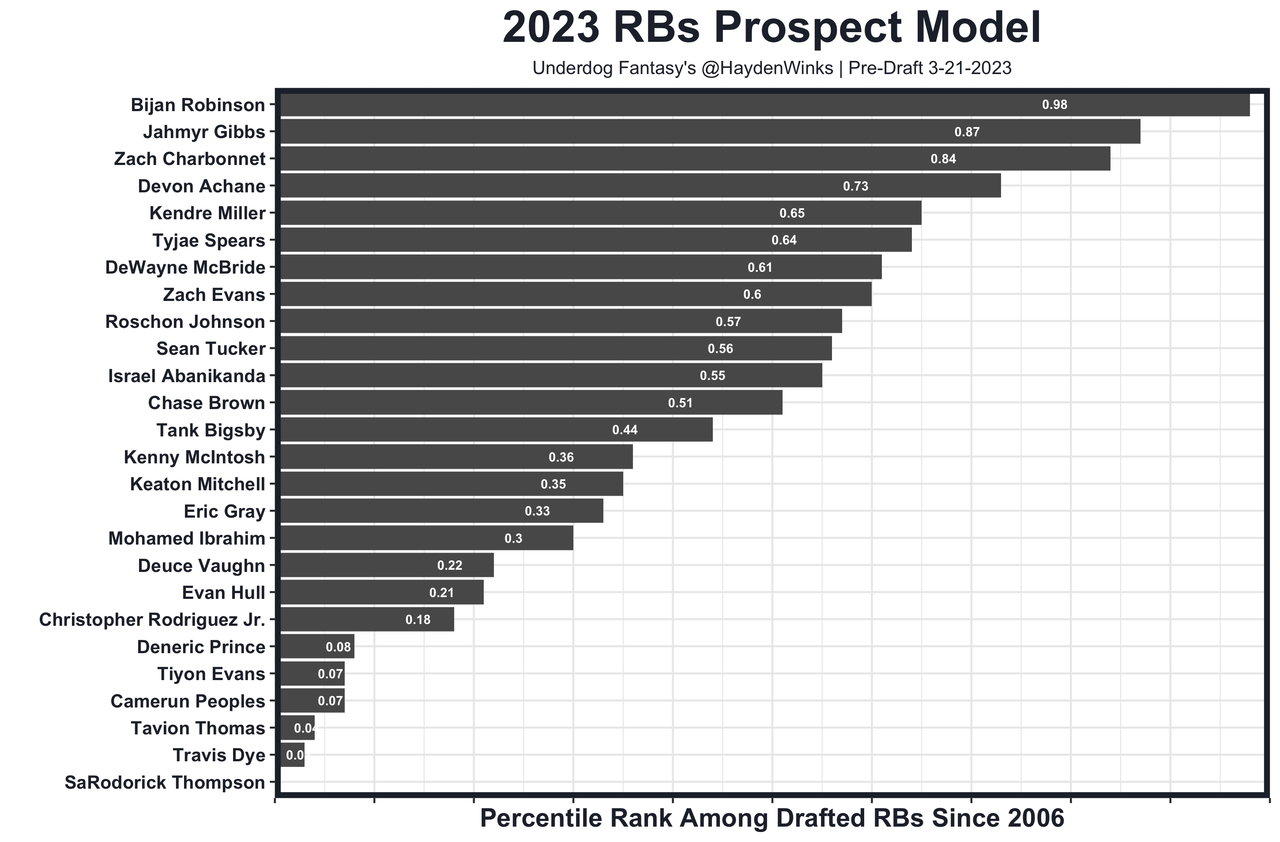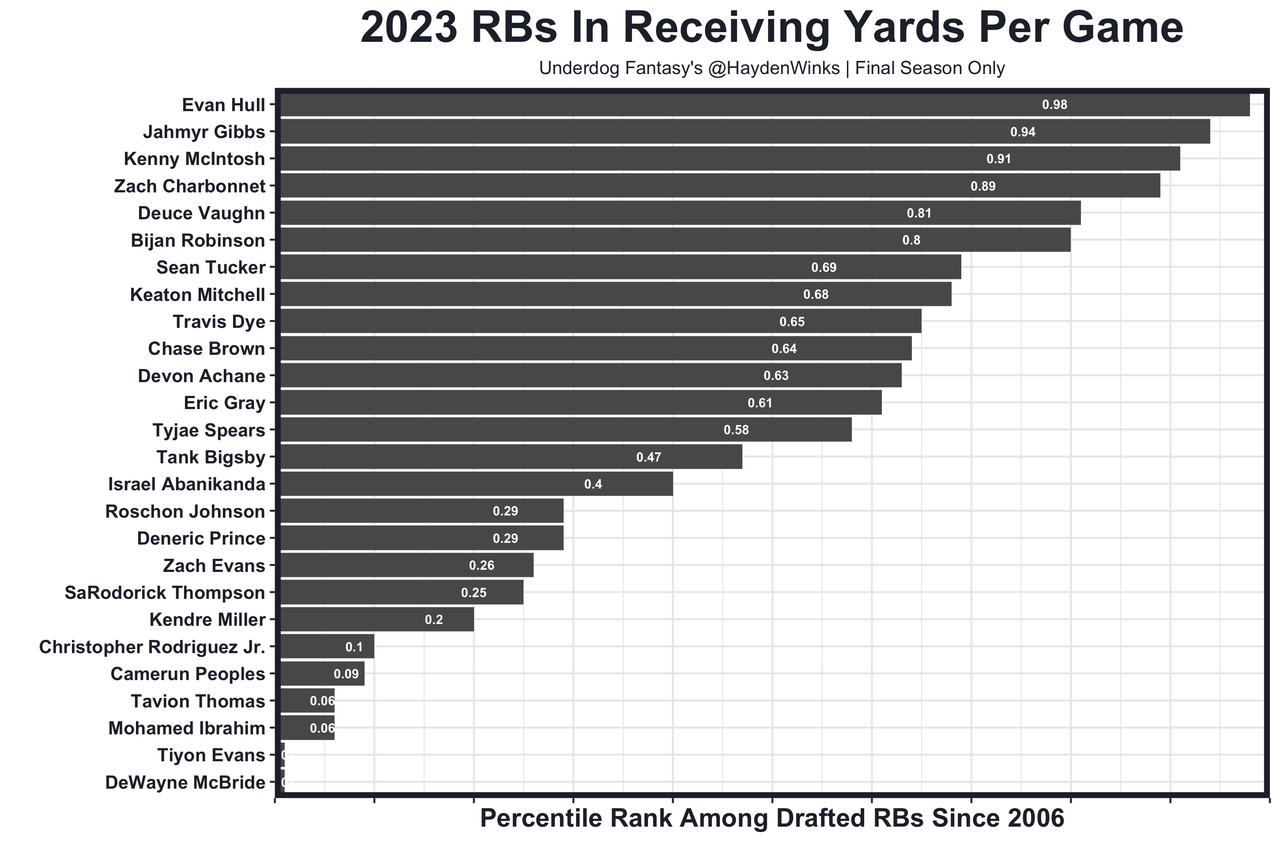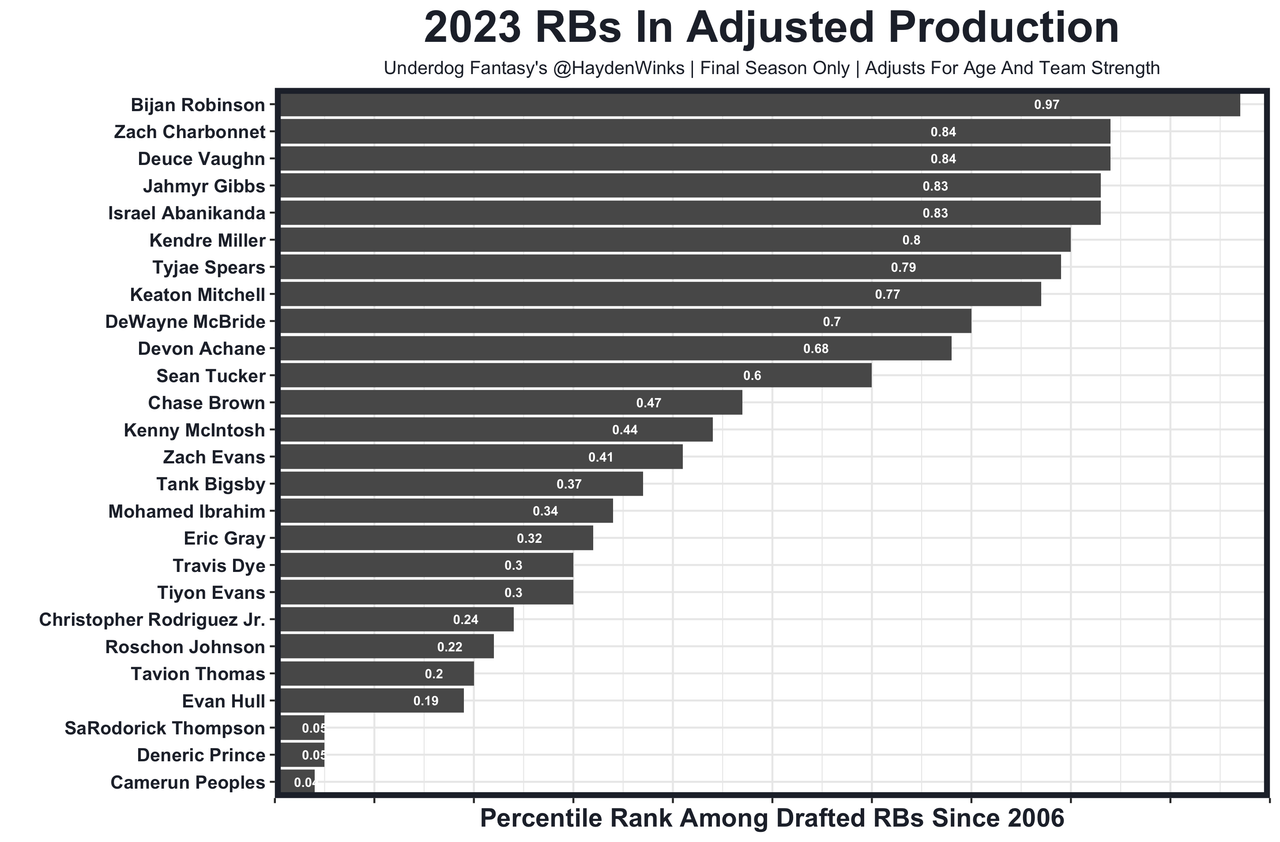2023 NFL Draft RB Rankings, Grades, and Profiles

2023 NFL Draft Running Back rankings, grades, profiles, analytics, and film notes for the consensus top-16 RB prospects -- Bijan Robinson, Zach Charbonnet, Jamhyr Gibbs, Devon Achane, DeWayne McBride, Roschon Johnson, Kendre Miller, Zach Evans, Tyjae Spears, Sean Tucker, Tank Bigsby, Kenny McIntosh, Keaton Mitchell, Israel Abanikanda, Eric Gray, and Deuce Vaughn. Hayden Winks drops his early looks at each prospect, with more notes coming as we get closer to the 2023 NFL Draft.
If you agree or disagree with these takes, you should go to Underdog Fantasy and play in our $1 MILLION fantasy football tournament that features the entire 2023 rookie class. That contest will close well before the draft begins, so go to the lobby now. Promo code 'underblog' gets you a $100 deposit match bonus. You'll love it.
1. Bijan Robinson (Draft Grade: Late Round 1)
Robinson (6’0”/220) looks like a 5-star recruit from the first play of tape you watch. He has NFL bellcow size and college production, racking up 1,000 rushing yards after contact per Sports Info Solutions (SIS) before declaring early. His power sticks out in short yardage, where he had a very nice 69% success rate on carries with three-or-fewer yards to go. He constantly finishes runs through defenders but has fantastic feet for a big back. Robinson’s jump cuts on outside zone runs are impressive, and he can get skinny through holes on gap runs. He’ll fit in any system, even if his long speed is closer to average. PFF credited him with 104 missed tackles forced in 2022, the only RB to clear the century mark in their database ever. Ever! More importantly for fantasy, Robinson could excel on passing downs. Don’t worry about his pass protection skills. Just rave about his diverse route tree. There are big plays on screens, check downs, wheels, skinny posts from the slot, and more on his Junior tape.
Ultimately, Robinson had 89th percentile production among drafted RBs since 2005 and he did so against college football’s toughest strength of schedule while competing with another NFL prospect in his own backfield. Anything other than multiple RB1 seasons would be a disappointment. The only trait separating him from Saquon Barkley type of prospects is elite speed, which can bite him on occasion when he gets jumpy at the line of scrimmage. Prime David Johnson, prime Ezekiel Elliott, or Joe Mixon with better receiving skills are all appropriate comparisons... My model = 98th percentile.

2. Zach Charbonnet (Early Round 3)
Joining Michigan as a 4-star recruit, Charbonnet transferred to UCLA (yuck) after an 11-touchdown freshman season and a Covid-shortened sophomore season. He posted back-to-back 1,300-plus yard and 13-plus touchdown seasons in his junior and senior years, ultimately finishing with 93rd percentile PPR points per game and 93rd percentile yards per game among drafted RB prospects during his 2022 season. At 6’1” and 220 pounds, he’s a classic early-down lead back who shines between the tackles with a no-nonsense style. His balance is a strength, as he constantly bounces off arm tackles with his big legs. Greek statues are jealous of his physique.
He led college RBs in EPA per carry, was fourth in success rate, and averaged a strong 4.2 yards after contact. His 7.1 yards per carry on 1st-and-10 and 2nd-and-10 runs is impressive, but his 72% success rate on carries with three-or-fewer yards to go projects well for red zone success and NFL touchdowns. The Bruin had moments of mean shoulder-lowering power, yet has patience and vision. His upright stance and average athleticism hold him back from a plethora of highlight runs, but he’s a well-spoken, smart player who checks boxes on passing downs for a powerful back. Charbonnet caught 24 and 37 passes in Chip Kelly’s offense, giving him a potential three-down profile heading into the NFL. I compare him to James Conner. The dynasty community is putting too much emphasis on him not being an early declare, especially with Covid effecting his experience... My model = 84th percentile.

3. Jahmyr Gibbs (Early Round 3)
A 4-star recruit, Gibbs split touches in a triple-option Georgia Tech offense as a freshman and sophomore before transferring to Alabama as a junior. His role more-or-less stayed the same in each offense, as a dynamic passing down back with juice on early down runs. He will gash defenses with high-end speed, particularly on outside zone, stretch, and pitch runs where he averaged 6.7 yards per carry according to SIS. 112 of his 151 Bama carries were off-tackle or to the complete outside, compared to just four carries inside the 5-yard line and ten carries with two-or-fewer yards to go. There is approximately zero power to his game and he maxed out at 192 touches in college, only averaging 12.6 carries per game as a junior. At 5'11" and 204 pounds, it'd be a surprise if he saw many NFL goal line carries. This is where the Alvin Kamara comparisons lose me.
Despite only having 50th percentile PPR points per game among drafted RBs since 2005, Gibbs has Tony Pollard potential as a change-of-pace rusher and difference-making passing down back. He kills linebackers with Texas and option routes from the backfield and has experience running real routes out wide. Defenders look like humans chasing an Australian Shepherd off a leash. Multiple 50-100 reception seasons are expected, as long as his pass protection issues don't creep up. Per PFF, he was 217th out of 251 college RBs in pass block grade on the 163rd most reps. In the right role, he should shine. Hopefully expectations don't get too crazy... My model = 87th percentile.

4. Kendre Miller (Early Round 4)
A 3-star recruit, Miller grinded his way to a junior-year breakout season during TCU’s National Championship run after leading college football with 5.0 yards after contact on a smaller sample as a sophomore. The 20-year-old early declare posted 1,515 total yards and 17 touchdowns in 2022, good for 46th percentile PPR points per game among drafted RBs. He’s an early-down, between-the-tackles lead back with impressive burst for a player his size (6’0”/220). He routinely surprised second level defenders by beating them to the edge, resulting in multiple big runs and a career 6.7 yards per carry. In space, he shows off a mini jump cut at top speed but otherwise doesn’t have a lot of east/west ability.
97% of his carries came out of shotgun, and he led college football with 1,058 yards on inside zone or power runs. Miller has nice vision and patience, making him a fit on inside zone in particular. Others at his size run with more physicality and he’s not the smoothest player in general, but he should compete for early down touches after recovering from a grade three MCL tear, which likely keeps him from testing. Anything on passing downs is a complete projection. He only caught 16 passes, and Horned Frog backs acted like check downs were never coming their way. I compare him to Sony Michel... My model = 65th percentile.

5. Roschon Johnson (Early Round 4)
Stuck behind likely first-rounder Bijan Robinson, Johnson’s production was limited to between 88 and 146 touches in all four Longhorn seasons. Most college backups don’t produce in the NFL, but he has the chance to be an exception because of his per-carry metrics. His 4.3 yards after contact is strong and his broken tackle rate over the last two seasons leads college football. His 56% success rate and +0.18 EPA per carry matched Robinson’s numbers. He does so by shaking off tacklers with strength at the first level. His open field ability is fine for a big back, too, but his best strength is timing and vision.
Johnson (6’1”/223) runs pro ready by waiting for his blockers to set up lanes and by reading linebackers at the second level. There are times when he can’t get skinny enough to make it through holes and his route running is like putting a rhino in the slalom, but he pass protects very well and has some experience as a fullback in 2-RB sets. He profiles as an early-down back with some versatility in different formations, especially with his football IQ. I expect him to last in the NFL and compare him to Samaje Perine, who plays more than expected because of his reliability... My model = 57th percentile.
6. DeWayne McBride (Early Round 4)
He is a Bowser-level tone setter. At 5’11” and 215 pounds, McBride comes equipped with NFL size, traits, and production as a quality sleeper. He declared early after a junior season that equated to 78th percentile yards per game among drafted RBs since 2005. He was second in rushing yards (1,713) in college football, had 19 touchdowns, and was third in PFF grade. His career 4.93 yards after contact is elite and pops up on tape constantly. McBride, who plays bigger than his listed size, runs with fire and low pad level at contact, using his massive legs to drive piles, but he also surprises with decent short-area burst and wiggle for a physical back.
His skills translate to a zone system; McBride finished third in rushing EPA on inside or outside zone carries last year per SIS. 11% of his total carries went for 25+ yards, most of which paired with a jump cut, spin move, or broken arm tackle. There are times when his feet can slide out from underneath him, but in total, he has a career 7.3 yards per carry. Unfortunately, there is zero pass game work in his profile. He subbed out on passing downs often, stayed in to pass protect (well) when he stayed in, and totaled just five receptions in three years. Five! There are obvious pros and cons to his game, but McBride can be an early-down lead back in the NFL like a slimmer Alfred Morris... My model = 61st percentile.
7. Devon Achane (Early Round 4)
Achane (5’9”/185) is a real SEC track star with 4.32-second forty speed. That’s how he plays football, too. A 4-star recruit, he operated as the Aggies’ bellcow during his junior year after splitting time with Isiah Spiller as a sophomore. He finished with 68th percentile PPR points per game among drafted RBs on a career 6.4 yards per carry before declaring early. He is slippery with sudden change-of-direction ability at the line of scrimmage but does most of his damage by beating defenders to the edge with rare burst. I'm talking Mario Kart mushroom boost speed here (and the triple mushroom one to be exact). He runs tough, too. The issue is mass matters in tackle football. He gets hit hard, managing a pedestrian 3.6 yards after contact per carry and a 58% success rate on his carries with three-or-fewer yards to go.
Ultimately, Achane will need to get more comfortable in an outside zone scheme (only 90 career OZ carries per SIS) to succeed as a Raheem Mostert clone. Unlike Mostert, Achane projects for a passing down role after racking up 24 and 36 receptions in his final two seasons. Many of them were dump offs, but he was also asked to run fast threes to the flats and wheel routes out of the backfield. I compare him to a smaller C.J. Spiller, who likely maxes out in the 10-16 touches per game range. If things go right, those could be highlight reel touches... My model = 69th percentile.
8. Tyjae Spears (Late Round 4)
Spears is a one-year wonder, with three seasons of under 150 touches before breaking out in year four with 1,837 total yards and 21 total touchdowns. That equates to 71st percentile PPR points per game among drafted RBs since 2005, though he gets dinged for strength of schedule and not declaring early. For an undersized back (5’10”/204), he runs hard and plays big. He’ll break arm tackles, can lower his shoulder a bit, and is elusive in space. He averaged 4.5 yards after contact (good), with a strong 72% success rate on carries with three-or-fewer yards to go. It’s unlikely that he’ll be a primary goal-line back given his size, but he can do it in a pinch. On 1st-and-10 and 2nd-and-10 runs, he averaged 7.8 yards per carry thanks to multiple big runs. He has below-average long speed for his size but as NFL burst to reach the second level. Ultimately, that’s more important. Spears is a wild card on passing downs, as he wasn’t used there specifically for the Green Wave. He caught 19 and 22 passes in his final two seasons, showing the physicality required for pass protection. It’s possible he is a bit of a tweener in the NFL with good not great traits in all phases, but he displayed tackle-breaking ability as a senior against non-Power 5 teams. I compare him to Khalil Herbert. It's worth noting that there have been iffy reports on his twice-torn ACL... My model = 64th percentile.
9. Zach Evans (Late Round 4)
A 5-star recruit and gifted athlete, Evans’ college career never worked out. He played 668 collegiate offensive snaps in total and had to transfer from TCU after a sophomore season consisting of committee usage. At Ole Miss, he maxed out at 156 touches across 12 games because he’s a highly inconsistent player. His vision might be the worst in the class, as is his pass protection recognition. There were big plays left on the table, even though he might be the most natural athlete in the class. His career 6.9 yards per carry are buoyed by multiple massive runs thanks to his effortless burst and balance. Getting Evans to the perimeter or developing his zone system comfort will be the key to unlocking his raw traits. Evans’ 22nd percentile PPR points per game among drafted RBs makes him a relative long shot but there is theoretical upside here. He is strong for his size and seeks contact at the end of runs. Concentration drops were a problem but his open-space ability projects well on passing downs if he can develop his pass protection abilities. He’s the most boom-bust back in the class... My model = 60th percentile.
10. Tank Bigsby (Late Round 4)
Bigsby checks a lot of the usual boxes as an SEC 4-star recruit, multi-year producer with three 900+ yard seasons, early declare, and 210-pounder. As a junior, he caught 30-of-42 targets for 180 yards. He can play some passing downs, but he’s not a natural because his balance and lateral ability are below average. He runs upright for a back with average height. Instead, he’s a north/south rusher with the physicality and leg drive to run up the gut. He averaged a sturdy 4.16 yards after contact, though some of that was forced by him. He was hit at the line on a ridiculously high 48% of his carries because his vision is in development. Ultimately, nobody plays more to their name than Tank Bigsby. He has the pure strength to be an early-down rusher but has to run with more decisiveness and develop a move out in space. His 36th percentile PPR points per game among drafted RBs and likely forgettable NFL Combine keep his ceiling in the committee range. I compare him to a slightly smaller Jordan Howard... My model = 44th percentile.
11. Israel Abanikanda (Late Round 4)
It scares me that some of these prospects were born in 2002. And Abanikanda wasn't born until October of 2022, meaning no legal Jager Bombs until Week 5 of his rookie season. Wild...
Anyways, Abanikanda broke out as a junior to the tune of 1,577 total yards and 21 total touchdowns. That's 87th percentile PPR points per game among drafted RBs since 2005. He's an analytics darling with high-end long speed for a 210-pounder. He gets to the second level with a decent feel for a backside cut on zone runs, but those are his primary strengths. He's built like Mrs. Incredible -- all legs, little torso -- which works against his start-and-stop and tackle-breaking ability. His 2.7 yards after contact is amongst the worst in the class and aligns with his upright running style. If he doesn't project for short-yardage power touches, then he'll have to win as a one-cut rusher on early downs after developing better timing and patience at the line. His receiving profile includes 12 receptions, a below-average 0.9 yards per route run, and few reps outside of the backfield. He's simply not built for agility on swing passes. I compare him to Chuba Hubbard... My model = 55th percentile.
12. Sean Tucker (Round 5)
He is the spreadsheet virgin king. Tucker broke out as a true freshman at Syracuse, then posted back-to-back 1,300+ total yard and 20+ reception seasons before declaring early as a 20-year-old. He has typical NFL size. In fact, he looks like he can shotput a motorhome. His muscular frame gives him strong size-adjusted straight-line speed (he flirted with a little track and field), but it also works against his creativity. He doesn’t move east/west at all, ranking 118th out of 169 college RBs in PFF’s elusiveness rating. His open field move is purely momentum, and at the line of scrimmage, he can be a little too hesitant. That latter issue can develop given his age, but 2.8 yards after contact is 2.8 yards after contact. Tucker caught 36 passes as a junior but that may trick people into thinking he has a layup passing down role. He battled drops, isn’t an advanced route runner (mostly screens and checkdowns), and only pass blocked on 8% of his dropbacks. His receiving production was simply getting the team’s most explosive player the ball in cheap ways. Not necessarily a bad thing, but he profiles closer to poor man’s A.J. Dillon or Gus Edwards rather than as a bellcow. He’ll be at his best in a one cut zone system where his high-end size and speed combination can shine. His PPR points per game was in the 50th percentile among drafted RBs since 2005... My model = 56th percentile.
13. Eric Gray (Round 5)
An older 23-year-old non-early declare, Gray needed to transfer from Tennessee to break out as a senior for the Sooners. His 1,595 total yard and 11-touchdown season equates to 56th percentile PPR points per game production among drafted RBs since 2005. His physical traits are mediocre, particularly his long speed and strength for a back of his size (5'9"/210). It looks like he plays with ankle weights on when he hits the open field, but he does have a signature dead leg cut that is effective for making a second-level defender miss. His stomping style plays to his advantage there. Overall, his 3.4 yards after contact are below average. Gray profiles as a No. 3 back, with enough size to run power and soft hands to operate on passing downs in a pinch. He caught 33 passes in his final season and can hold his own in pass protection. He didn't split out wide as a receiver in college, rather operating as a check down option primarily. I compare him to Ke'Shawn Vaughn... My model = 33rd percentile.
14. Kenny McIntosh (Round 6)
Patiently waiting behind multiple NFL backs at Georgia, McIntosh broke out as a senior during Georgia’s National Championship run, to the tune of 1,334 total yards, 12 total touchdowns, and 43 receptions. That’s good for 33rd percentile PPR points per game among drafted RBs since 2005. He is a tall, thinly built receiving back and arguably the most natural receiver in the class. He has experience running swings, wheels, screens, angles, choice routes from the slot, and more. His timing as a receiver is great, ultimately averaging an elite 2.2 yards per route run while most RB prospects are at about half that. The rest of the profile is forgettable. McIntosh (6’0/210) doesn’t have NFL power (3.1 yards after contact) and only had 34 attempts with three-or-fewer yards to go, meaning he’ll have a one-dimensional role on passing downs. He needs to improve in pass protection, where he was 133rd in pass blocking reps last year, too. The 23-year-old rookie and non-early declare has a limited ceiling, as his lateral ability and top speed are below average among receiving types, but his natural hands and route running are NFL ready. I compare him to a less shifty Kenyan Drake... My model = 36th percentile.
15. Keaton Mitchell (Round 6)
This guy goes first overall in flag football. Mitchell's speed and lateral ability shine in the open field and while improvising at the line of scrimmage. His small frame (5'9"/184) makes him very jumpy at the line of scrimmage -- he bounces plays outside constantly -- but he has joystick movements and pinch-runner burst. He led college football with 54 runs of 10+ yards en route to a 7.2 YPC average, despite a middling 3.6 yards after contact. His experience is in a zone system, where he finished with the second-most rushing EPA on outside runs in college football per SIS. Mitchell's 23.9 PPR points per game are good for 73rd percentile production among drafted RBs since 2005, and he'll be a 21-year-old rookie and early declare. There are reasons for change-of-pace optimism here, but he needs to win on pass downs. He caught 22 and 27 passes in his final two years but did run into a couple of drops. After the catch, he can go from 0-to-60 quickly and beat linebackers around the corner. I compare him to a thinner Travis Etienne... My model = 35th percentile.
16. Deuce Vaughn (Round 7)
I’m rooting for Vaughn. Big time. Anyone who can handle 284 and 335 Power 5 touches in back-to-back seasons at 5’6” and 176 pounds is an absolute dog. His sophomore season of 28.3 PPR points per game equated to a 91st percentile ranking among drafted RBs since 2005. His junior year, 59th percentile. Because of his size, however, Vaughn will be transitioning into a passing-down only role in the NFL, though he ran a plethora of ground concepts in college. He had at least 25 receptions in all three seasons before declaring early as a 21-year-old rookie. He is a fairly comfortable receiver and moved around the formation, lining up out wide or in the slot on 178 snaps throughout his career. Screens, wheels, swings, and option routes from the slot are in his bag. Others at his size show more burst and agility. He only forced five missed tackles on 58 targets as a junior and rarely was pulling away from defenders in open space. Those spaces will only get tighter at the next level. Perhaps most concerning is his size in pass protection. He chops incoming blitzers at a very high rate and simply doesn’t have the mass to hold his ground, even if he’s a tough player. Tarik Cohen was a more dynamic athlete in his short NFL career, but that’s the role Vaughn is hoping for... My model = 22nd percentile.